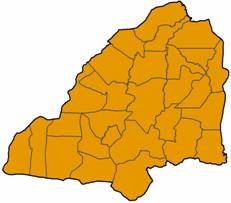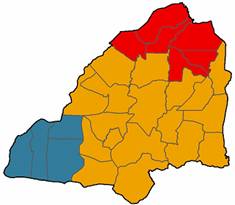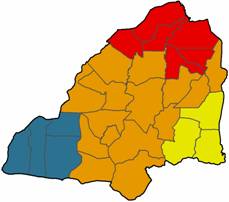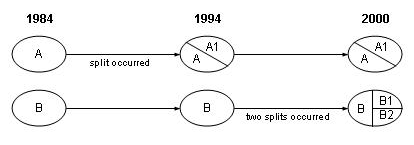Village-Level Concepts/Issues...
The 1984 Nang Rong District Boundary
The number of districts in the
Buriram province have increased over time, mainly for administrative purposes. The increase in
districts usually happens by one district splitting into 2 or more
districts. This, of course, affects the district
boundaries. Please examine the maps below to see how the original
1984 Nang Rong district boundary and shape changed from one district
in 1984 (Nang Rong) to four districts in 2000 (Nang Rong, Chamni, Non Suwan and Chalermprakiet):

|

|

|
| 1984 Survey |
1994 Survey |
2000 Survey |
Despite these changes in district boundaries, villages within
the
original 1984 Nang Rong district boundary were assigned a unique
village number during the three rounds of data collection. Please
note that in
the 1984 survey this only included a sample of all the villages within
the
district boundary, while in the 1994 and 2000 surveys all
villages within the original 1984 Nang Rong district boundary were assigned
a unique village number.
The Split Villages
In the same manner as the districts, the number of villages and
their boundaries changed over time as well. As the villages
grew, they would sometimes split into
smaller villages, again mainly for administrative purposes. There
have been
several villages within the study area that have split into 2 or more
villages since the first round of data collection in 1984.
The diagram
below shows just a couple of ways a village may have split over time:

Village A split into A and A1 between 1984 and 1994.
Village B split twice between 1994 and 2000 creating two more villages
B1 and B2. Due to the splits, the number of study villages
that were administered the household survey increased from the original
51 in 1984 to 76 in 1994 and then 92 in 2000. The number
of villages that were administered the community survey went from the
original 51 in 1984 to 310 in 1994 and then 346 in 2000.
Please note again that the 1984 community survey was administered to only a
sample of all the villages within the old Nang Rong district boundary,
while the 1994 and 2000 community surveys included
all villlages.
"This Village"
The use of the phrase "this village" applies to the 1994 and
2000 household data and is related to the split villages concept.
For some questions in the household questionnaires, "this village"
refers to the 1984 boundary
of the study village. For example, if a 1984 study village had
split into 3 villages by 2000, like Village B in the split village
diagram above, the
questions in the 2000 household questionnaire would be referring to the
three villages - B, B1 and B2 - as a single entity. Please note,
however, that each of the three villages would still be administered
their own
2000 community questionnaire.
Invalid Village Sets
Given that the three village identifier variables -
vill84,
vill94 and
vill00
- are not coded in the same manner, the Nang Rong Projects has a master
village data set (or a translation table) which shows how the villages
link back and forth across time from 1984 to 1994 to 2000. For
instance, if
vill94="2022", then according to the master village data set, the 1984 and 2000 village identifiers should be:
vill84="22" and
vill00="020809," respectively.
This would be a valid set of village identifiers. In the 1994 and 2000 surveys, 99% of the households have a valid set of
village identifiers; however, there is a small group of households in
each survey that do
not have a valid set. In the 1994 survey, there are 9 such households (flagged as
v8494fl=1), while in the 2000 survey there are 27 households (flagged as
v9400fl=1). Here are four households from the 1994 and 2000 surveys that have invalid village sets:
1994
Survey
|
HHID94
|
VILL00
|
VILL94
|
VILL84
|
20120721
|
180101
|
2012
|
11
|
20210541
|
020812
|
2021
|
22
|
|
2000
Survey
|
HHID00
|
VILL00
|
VILL94
|
VILL84
|
020309101
|
020309
|
2042
|
42
|
021409017
|
021409
|
2045
|
45
|
|
The first 1994 household originated in village 11 in 1984 and
should have linked to village 2011 in 1994; however it linked to
village 2012. In the same way, the second 1994 household
should have linked to village 2022 in 1994, but instead it linked to
village 2021. In 2000, the first household came from
village 2042 in 1994 and should have linked to 020308 in 2000, but
instead linked to
020309. In similar fashion, the second 2000 household that
originated in 2045 should have linked to village 021405 and not
021409. Given the invalid village links, it certainly appeared
that
the households moved from one village to another between the data
collection years. However, on close inspection, it was discovered
that these households were most likely part of smaller
"sub-villages" that were located near two "main" villages.
In one survey year, one of the main villages included
the sub-village households on its village roster, and then in
the following survey year the second main village included the same
sub-village on its
village
roster. So, the household did not move, but the boundaries
around them changed.
In general, the invalid village sets are not a problem in working with
the data. However, the one exception is when analysis or
variable construction, using the
1994 or 2000 data, calls for grouping
individuals or households into the original 51 villages from
1984. Due to this small number of households with invalid
village sets, the analyst should not
use the VILL84 variable for grouping the individuals or
households, but instead should use a variable called V84.
The V84
variable is in the individual-level data sets in 1994 and 2000.
It is basically the 1984 village number of the individual that
corresponds
to the village in which they are currently residing, and not the 1984
village number that they necessarily link back to.

